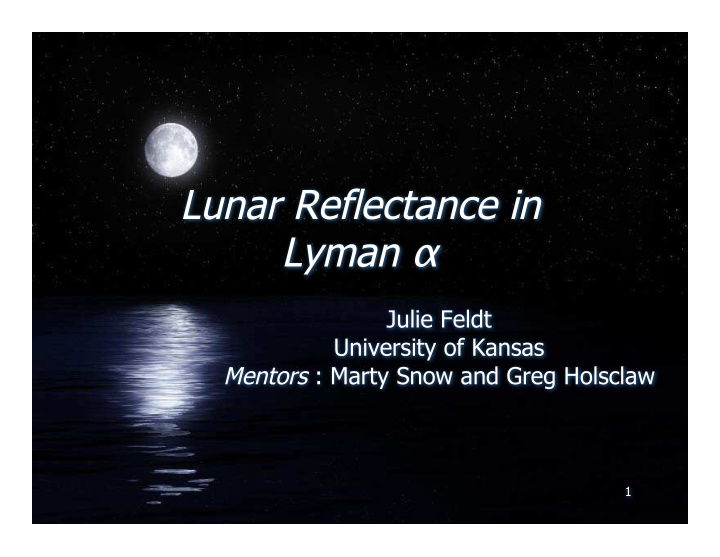



Lunar Reflectance in Lyman α Julie Feldt University of Kansas Mentors : Marty Snow and Greg Holsclaw 1
Outline i. Scientific Background ii. Data Reduction iii. Lunar Albedo measurement iv. Future Work 2
Why is the Lunar Albedo important? What is Albedo? Learn more about the Lunar Surface Properties Calibration for other Instruments E / � A M M = M E / � S 3
Remote Sensing of the Moon Mineralogy Surface composition Space Weathering Changes to the reflectance properties of a material that’s exposed to the space environment for long periods of time Photometry Reflectance properties as a function of phase angle depends on details of the surface 4
Lunar Observations as a Calibration Standard Photometrically stable Visible from any Earth orbit Ultraviolet instruments are difficult to calibrate accurately Limited sources that are well-characterized Carefully measuring the Moon with SOLSTICE could provide an ultraviolet standard from which future instruments could benefit The Robotic Lunar Observatory (ROLO) is a US Geological Survey project with this goal in the visible to near-infrared; SOLSTICE would extend this to the UV 5
Geometrical Terms Phase Angle Solar Zenith Angle 6
Wavelength Coverage SORCE Satellite – SOLSTICE instrument measures UV (~115-310 nm) – Lyman α (121.6nm) 1 nm resolution in stellar mode and 0.1 nm resolution in 7 solar mode
Solar Spectrum - Lyman α 8
Lunar Spectrum
Airglow SORCE satellite is still within part of the Earth’s atmosphere Caused by light scattering off the hydrogen atoms of the atmosphere This background light adds to the lunar signal that SOLSTICE observes 10
Determine Airglow • Three scans of just the atmosphere • Data Reduction • Each peak is at a different Solar Zenith Angle • 218.6° • 207.4° • 196.2° • Gaussian Fits
Background Prediction Polynomial fit 6 th order χ ^2 = 57.395 12
Lyman Alpha after Background Subtraction 13
Lunar Phase Curve at Lyman Alpha 14
Opposition Effect 15
Summary Lunar albedo can be a good thing to know Lunar properties Calibration Reduced the SOLSTICE data Airglow subtraction Found the lunar albedo
Future Work Improving the model to prevent the scatter in albedo Try other fits Testing the background prediction to find the uncertainty 17
Questions?
Space Weathering in the Ultraviolet Lunar Rocks and Soil Spectra of lunar • soils exhibit an upturn toward shorter wavelengths in the UV, while the spectra of lunar rocks do not exhibit this reversal, this suggests that the optical effects due to space weathering in the visible are different in the ultraviolet 19
To Do This… Make Corrections Issues with the data Flybacks Observations without data Observations with bad data Timing of instrument off In the lunar observations, shifting of Wavelength due to movement of the Moon Remove background - Airglow according to the position of the satellite to predict background 20
Data Reduction 21
Data Reduction Filtering data points Observations without data Observations with bad data Shifting of Wavelength due to movement of the Moon 22
To Do This… Make Corrections Issues with the data Flybacks Observations without data Observations with bad data Timing of instrument off Shifting of Wavelength due to movement of the Moon Remove background - Airglow according to the position of the satellite to predict the amount of background 23
Recommend
More recommend